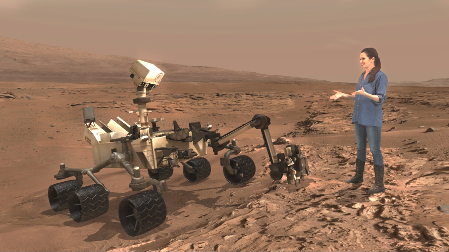WASHINGTON—Rodney Grubbs, NASA Imagery Experts Program Manager, will present “More and Better Pixels, How NASA Plans to use HDR, 4K, VR and Other Technologies to Take Everyone Along for the Ride to Mars” at 1 p.m. on Thursday, Dec. 8, at the Government Video Expo at the Walter E. Washington Convention Center in Washington, D.C. Grubbs will discuss how NASA is currently developing plans for human exploration of Mars by the 2030’s.

Government Video recently spoke with Grubbs about his upcoming presentation at GV Expo and NASA’s future plans for virtual reality and other advance imaging technologies.
Government Video: Can you give us some background on what you will be presenting at GV Expo?
Rodney Grubbs: I will share some links to some interesting VR, UHD and Mars content. I will discuss how VR/360, HDR, and UHD technology actually solves technical challenges for acquiring imagery in space.
GV: How is NASA currently using 4K and HDR technology?
RG: A lot of historically significant events are captured in 4K or higher to provide a relevant archive for the future. 4K and higher resolution is also used in situations where the imagery provides analysis of systems, such as rocket engine tests (as a replacement for film). HDR similarly provides a replacement for film. Rocket launches are notoriously hard to capture because the engine plume is so much brighter than the rocket above it.
GV: How did you obtain/develop VR footage from Mars?
The professional video industry's #1 source for news, trends and product and tech information. Sign up below.
RG: Mars VRs are actually stitches of hundreds or sometimes even thousands of individual digital photos. We can’t get “video” from Mars, so this is the next best way to evaluate the rover’s surroundings.
GV: How will motion imaging complement human exploration of space? And will it be a substitute for certain missions?
RG: Motion imaging provides situational awareness for ground controllers, letting them monitor spacecraft operations, determine extent of damage if there is a collision, confirmation of other sensors during rendezvous and docking with other spacecraft, and monitoring conditions when humans are not on board. Motion imaging can also document “near misses”, where other sensors were not tripped but something came close to causing a problem, such as debris strikes. Since a Mars mission will require crew to be away from the Earth and their families for possible two or more years, motion imaging is a way for them to stay connected to life on Earth and their families. We are testing motion imaging as a substitute for crew with robots on board the ISS, so a crew member or ground controller can “see” what the robot sees as it makes its way on the outside of a spacecraft.

GV: What are NASA’s plans to use motion imaging technology to explore the moon and asteroids? Is there a timeline for this?
RG: NASA and its international partners have been working on a plan to use the area around the moon, referred to as “Cislunar space,” as a place to conduct Mars precursor missions, that include rendezvous with near-Earth asteroids and sorties to the Moon. These plans are preliminary and depend on the various space agencies and their governments providing the resources. If approved, these activities would start in the early 2020’s leading to a Mars mission in the middle of the 2030’s.
GV: Are there earthbound applications that can benefit from NASA’s motion imaging technology development?
RG: For the most part we are now in an era where NASA doesn’t create imaging technology from scratch. We use commercial products and modify them for space flight. There are some areas where communications or artificial intelligence capabilities NASA is creating, which happen to add to our imaging technologies, could benefit Earth-bound applications. For example, NASA is helping to create something called “Delay Tolerant Networking,” which is critical for enabling the "Solar System Internet." Because of the distances involved, regular two-way internet protocols are impractical. New protocols that allow links with high latency or breaks in links without disrupting the data flow are maturing and could be practical here on Earth as well. NASA is also testing optical communications links to increase the amount of data (including high resolution imaging) that can be sent from remote spacecraft. Finally, cameras with a 360 degree field-of-view combined with self-aware tracking software could enhance the ability of security systems here on Earth.
GV: How important is virtual reality in space exploration/astronaut training?
RG: I’ve experienced walking in the International Space Station via VR at NASA’s “holodeck” at Johnson Space Center. When combined with some physical characteristics it provides a very realistic experience that augments training with full-scale mock-ups. We are just at the beginning of use of this VR technology for training. I suspect we will see a shift from full-scale mock-ups to VR over the next decade.
GV: Where do you expect we will be a decade from now in terms of imaging technology advances?
RG: I think the use of cameras as sensors, combined with artificial intelligence, tracking, and object recognition, will continue to expand. We’re already seeing it in cars and drones, next will be vacuum cleaners, lawn mowers, bicycles, and so on. So many devices will use cameras with embedded intelligence and software to automate much of our lives.

GV: In addition toimages.nasa.govand the NASA UHD channel, what are some of the other ways NASA is promoting/distributing its high res images/video footage to the general public?
RG: We will continue to expand our ability to make content available to the public via as many platforms as possible. We are hoping to integrate these capabilities into services that can be used with smart TV’s and IPTV boxes like Amazon’s Fire, Roku, and Apple TV. As bandwidth to people’s homes and mobile devices expands we can make raw or less compressed content available to viewers.
To register for Government Video Expo, Dec. 6-8, visitwww.gvexpo.com.
Tom has covered the broadcast technology market for the past 25 years, including three years handling member communications for the National Association of Broadcasters followed by a year as editor of Video Technology News and DTV Business executive newsletters for Phillips Publishing. In 1999 he launched digitalbroadcasting.com for internet B2B portal Verticalnet. He is also a charter member of the CTA's Academy of Digital TV Pioneers. Since 2001, he has been editor-in-chief of TV Tech (www.tvtech.com), the leading source of news and information on broadcast and related media technology and is a frequent contributor and moderator to the brand’s Tech Leadership events.

